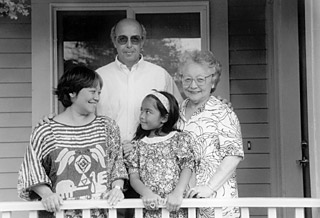Conclusion
The transformation of an all-male art for the laborer class to today’s Cantonese opera is significant. As Chinese immigrants became more affluent and established, they moved out of Chinatown and moved into American middle-class suburbia. Cantonese opera has taken up a new meaning for many “successful” Chinese Americans. It is a connection to home, a cultural heritage, and an expression of wealth and status. The new “rebirth” of Cantonese opera happened in the 1980s, as some retired master performers moved to the Bay Area and started teaching local people. It is an expensive art to practice and most participants are amateurs. Even as most traditional arts are “dying” without proper education and without government support, Cantonese opera is surprisingly “alive” in the Bay Area. It is the traditionally voiceless women who have taken on a man’s job to transmit the art, to help strengthen the community, and most significantly, to project their female voice.
The curtains have risen and a woman is in the spotlight. The audience gradually quiets down. “Can you hear me?” She asks. Yes, absolutely. Pay attention! The show is starting. A woman is singing.
Works Cited
Alta California, October 16, 1852.
Alta California, October 20, 1852.
Ashbury, Herbert. The Barbary Coast: An Informal History of the San Francisco Underground. New York: Alfred A Knopf, 1933.
Atherton, Gertrude. My San Francisco: A Wayward Biography. New York: Bobbs Merrill Co., 1946.
Bulletin, December 6, 1856.
Bulletin, March 5, 1860.
Coolidge, Mary Roberts. Chinese Immigration. New York: Henry Holt, 1909.
Figaro, November 14, 1878.
Fong, Stacey. “Bay Area Cantonese Opera.” Available at: http://www.pearlmagik.com/bayareacantoneseopera/Home.htm.
Herald, October 8, 1852.
Lei, Daphne Pi-Wei. Interview with Stacey Fong (January 27, 2003).
–. Interviews with Laura Ma (June 23, 2001 and February 11, 2003).
–. Interview with Nancy Wong (February 11, 2003).
–. Interview with Samuel Wong (July 8, 2001).
–. “The Production and Consumption of Chinese Theatre in Nineteenth-Century California.” Theatre Research International 28.3 (October 2003).
Riddle, Donald. Flying Dragons, Flowing Streams: Music in the Life of San Francisco’s Chinese. Westport, CT: Greenwood Press, 1983.
Rather, Lois. Chinese Theatres in America. Unpublished manuscript. 1943.
San Francisco Chronicle, December 13, 1855.
Yung, Judy. Unbound Feet: A Social History of Chinese Women in San Francisco. Berkeley: University of California Press, 1995.




